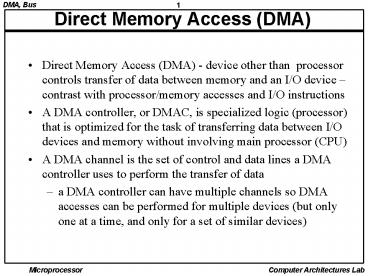Direct Memory Access DMA - PowerPoint PPT Presentation
1 / 13
Title:
Direct Memory Access DMA
Description:
Direct Memory Access (DMA) - device other than processor controls transfer of ... A DMA controller, or DMAC, is specialized logic (processor) ... Bus Mastership ... – PowerPoint PPT presentation
Number of Views:2496
Avg rating:3.0/5.0
Title: Direct Memory Access DMA
1
Direct Memory Access (DMA)
- Direct Memory Access (DMA) - device other than
processor controls transfer of data between
memory and an I/O device contrast with
processor/memory accesses and I/O instructions - A DMA controller, or DMAC, is specialized logic
(processor) that is optimized for the task of
transferring data between I/O devices and memory
without involving main processor (CPU) - A DMA channel is the set of control and data
lines a DMA controller uses to perform the
transfer of data - a DMA controller can have multiple channels so
DMA accesses can be performed for multiple
devices (but only one at a time, and only for a
set of similar devices)
2
DMA (cont.)
- At minimum, a DMA operation needs the channel
number (which I/O device requires the DMA), a
beginning address in memory for the transfer, the
number of bytes to transfer, and the direction of
transfer (I/O to memory, or vice-versa) - The processor kicks off the DMA activity with an
ordinary I/O write to a control register in the
DMA controller, then continues fetching and
executing instructions as usual - When DMA activity is finished, DMA controller
interrupts the processor, resulting in execution
of ISR for the DMAC - DMAC more efficiently transfers data blocks
between I/O device and memory than the CPU (why?)
-- also, the CPU is freed to perform other tasks
(overlapped or concurrent)
3
DMAC Connection
4
3 Modes of DMA Operation
Byte
Burst
Block
5
Bus Mastership
- DMA is an example of where the central processor
or CPU turns control of the bus over to another
device (a DMAC) - A device that has control of a bus, up until now
the CPU, is known as a bus Master memory
components and non-DMA I/O devices are known as
bus slave components - In early system busses, only processor and a DMAC
could have ownership of bus (i.e., become the Bus
Master) - Modern system busses (e.g. PCI) allow any I/O
device to become bus master an I/O device that
can become the bus master can perform DMA itself
instead of using a DMAC - If all I/O cards can become bus master then dont
need a separate DMA controller each card is a
DMAC
6
Bus Arbitration
- A piece of control logic known as the arbiter
must decide which device gets ownership of the
bus this control logic resides in the system
chipset and is a part of the overall system bus - Two lines are used for each peripheral that can
become bus master - Bus Request used by device to ask for control
of bus (arbiter input) - Bus Grant used by arbiter to grant bus to
device (arbiter output) - A peripheral typically has control of bus for a
maximum number of clock cycles (typically 32)
before it must release bus to the arbiter. - Bus is a shared resource, shared by potential bus
masters priorities are necessary for multiple
requests similar to interrupt priorities
7
Bus Arbiter
Arbiter
Br
Bg
Br
Bg
Br
Bg
Device 1
Device 2
Device
Local Bus, e.g PCI
Number Br/Bg pairs determines maximum number
devices on bus (i.e. slots on bus) Br Bus
request and Bg Bus grant
8
Bus Terms, Glossary
- A Bus is a mechanism for multiple devices to
talk to one another (to transfer data,
synchronize, etc.) - When one device talks, all others hear
- Data can be transmitted over bus in parallel or
serially - USB, IEEE Firewire are examples of serial busses
- PCI, ISA, SCSI are examples of parallel busses
- Bus may support only one master, or multiple
masters - If support multiple bus masters, must either
support bus arbitration to decide master or
schedule the bus accesses among the multiple
masters (time division multiplexing)
asynchronous vs synchronous sharing
9
Typical PCI Based x86 Computer Architecture
10
AMD Motherboard
11
Bus Terms, Glossary (cont.)
- The system bus is the bus that connects directly
to pins of the processor also known as processor
bus. - These days, system bus only has cache memory and
the system chipset connected to it - Multiple processors may connect to system bus
- The system chipset will transfer data between the
system bus and any other busses that make up the
system (will act as a bridge between system bus
and other busses).
12
Bus Terms, Glossary (cont)
- A local bus is a bus that stays inside the box
(cards plug into the bus via slots on
motherboard), forms a high speed path between
memory and peripherals - Will be a high bandwidth bus (wide and fast --- a
parallel bus that is clocked at high rate) - lines (address, control, data) run a short
distance - The PCI bus is an example of a local bus system
chipset connects PCI bus to processor (system)
bus.
13
Bus Terms, Glossary (cont)
- A peripheral bus is a bus that goes outside the
box to connect peripherals to memory. - Will NOT be as high bandwidth as system bus
(slow) - Will support a wide range of speeds (flexible)
- Can be either serial (Firewire, USB) or parallel
(SCSI) - lines can run long distance compared to system
busses - Firewire, USB, SCSI (for disks, scanners,
CDROMs), EIDE (for disks, CDROMs) are peripheral
busses.































